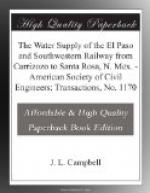Wood Staves.—The staves of this pipe are of Michigan and Canadian white pine. This pine cannot now be had of clear stuff or in long lengths in large quantities; otherwise, it is unexcelled. Douglas fir and yellow pine, coarser and harder woods, have the advantages of clear lumber and long length. Cypress is not as plentiful, and redwood is costly. The mill tests did not determine definitely the minimum degree of seasoning necessary, and press of time compelled the acceptance of some rather green lumber. Service tests do not show that there is any abnormal leakage from pipe made of such lumber, and it could not now be distinguished in the trench by such tests. Undoubtedly, however, thorough air seasoning should be required.
Bored Pipe.—Owing to its small size, a part of the 3-1/2-in. pipe was bored from the log. This was a mistake, for bored pipe has a rough interior and a reduced capacity. The inspection and culling are difficult and unsatisfactory, and imperfections readily apparent in a stave frequently escape detection in bored pipe.
Pipe Joints.—The chamber and tenon of this pipe is an all-wood joint, 4 in. deep. An iron sleeve makes a better and stronger joint. It compensates for any lack of initial tension in the banding over the chamber of the wood joint, and secures full advantage of the swelling of the wood. Cast iron is better than steel; it is more rigid, and its granulated surface breaks up the smoothness of the wood surface swelling against it. One objection to the cast-iron sleeve is that of cost, but it adds 4 in. to the effective length of every section of pipe, as compared with the wood joints. On the Pacific Coast, a banded wood-stave sleeve is used with success.
Coating.—To preserve the banding from corrosion and the wood from exterior decay, the pipe is thoroughly enveloped in refined asphalt having a flow-point adjusted to the prevailing temperature during shipment and laying. One grade can be used through a considerable range of temperature. This coating endured a 2,000-mile shipment successfully. Each piece was carefully inspected along the trench, and any break in the coating was thoroughly painted with hot asphalt. Enough of the latter came in barrels, with the pipe, from the factory.
The first 37 miles of this pipe has been in service for two years. Recent inspections show the coating to be in excellent condition and the steel underneath to be bright and clean. In some cases, where the initial pressure and leaking between the staves of the dry pipe were great, the escaping air and water lifted the coating into bubbles. At some points where this lifting was great enough to rupture the asphalt, and the soil is heavily charged with alkali, some corrosion has begun.
The integrity and impermeability of this asphalt coat are quite as vital as constant saturation. This coating protects the entire pipe from exterior contact with destructive agencies. With such effective exterior protection, a constantly full pipe is not so imperative. In the exterior protection of the wood, this coated pipe has quite an advantage over continuous stave pipe.




